The analysis carried out by Neudorf is known as Accessibility Profile Analysis (APA), which calculates how many jobs could be reached for a given cost ($) using the least cost travel mode. “Generalized Costs” include dollar estimates of the time spent traveling, and fixed costs of travel (ie. fares, gasoline). “Reachable destinations” in this case are the number of accessible jobs for a given transportation cost.
APA can be used to show areas underserved by transit, to identify areas with higher transportation “barriers to entry” to the local job market, and to find neighbourhoods that have poor employment access and/ or infrastructure deficiencies. Furthermore, it can be used to evaluate a new transit system such as bus, light rail transit, or subways, and its ability to deliver high access to jobs, parks or recreation at a low generalized cost. It could also be used to determine impacts to a transport system by changing a piece of infrastructure or introducing a new travel option. For example, it could be used to determine the result of changes to a transportation system by shifting from A) streetcar to B) subways; or, examining the differences between different modes such as A) bus, B) express bus, or C) light rail transit.
To read more background about Accessibility Profile Analysis and our other research, click here.
To view a poster version of this content, click here.
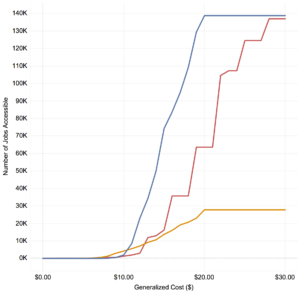

In Doon (TAZ 7466), the only effective way to reach employment is by driving, with a large barrier to entering the job market. Based on the 2006 data, this area could have benefited from increased transit and pedestrian facilities, and more local employers.

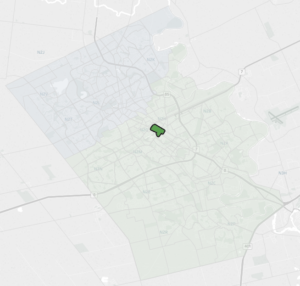
In Downtown Kitchener (TAZ 7141), transit and walking were the most cost efficient way to reach jobs. Residents had a low barrier to entry, and in 2006 had an excellent walking environment available.

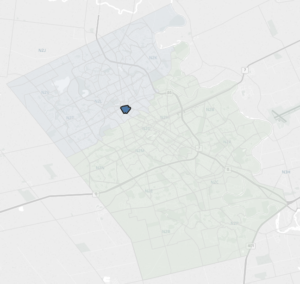 In Uptown Waterloo (TAZ 7105), public transit and walking were the best ways to reach employment in 2006. This is characteristic of a core urban area, and the low initial cost to travel jobs indicated a higher presence of localized employment available in 2006.
In Uptown Waterloo (TAZ 7105), public transit and walking were the best ways to reach employment in 2006. This is characteristic of a core urban area, and the low initial cost to travel jobs indicated a higher presence of localized employment available in 2006.
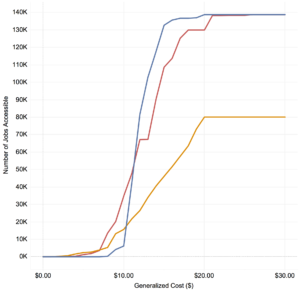
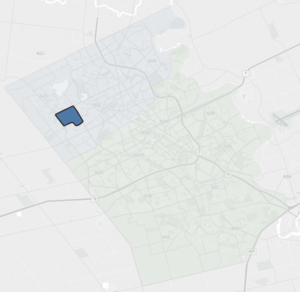 In Beechwood (TAZ 7253, taking transit or walking was more effective for shorter trips – above $11 using a car was the best travel mode, however, transit mirrors driving closely, indicating transit service provided modal redundancy in 2006.
In Beechwood (TAZ 7253, taking transit or walking was more effective for shorter trips – above $11 using a car was the best travel mode, however, transit mirrors driving closely, indicating transit service provided modal redundancy in 2006.

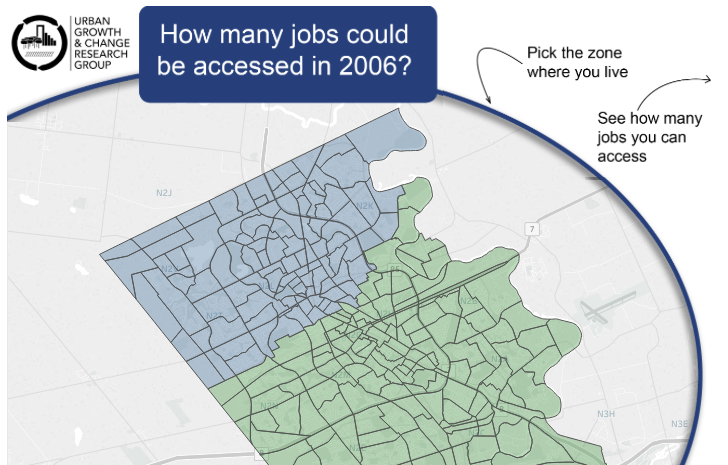





 In Uptown Waterloo (TAZ 7105), public transit and walking were the best ways to reach employment in 2006. This is characteristic of a core urban area, and the low initial cost to travel jobs indicated a higher presence of localized employment available in 2006.
In Uptown Waterloo (TAZ 7105), public transit and walking were the best ways to reach employment in 2006. This is characteristic of a core urban area, and the low initial cost to travel jobs indicated a higher presence of localized employment available in 2006.
 In Beechwood (TAZ 7253, taking transit or walking was more effective for shorter trips – above $11 using a car was the best travel mode, however, transit mirrors driving closely, indicating transit service provided modal redundancy in 2006.
In Beechwood (TAZ 7253, taking transit or walking was more effective for shorter trips – above $11 using a car was the best travel mode, however, transit mirrors driving closely, indicating transit service provided modal redundancy in 2006.